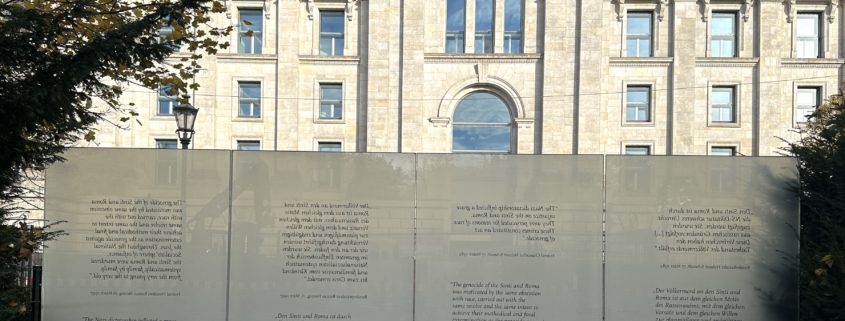Lost Narratives: The Roma Struggle for Recognition in Europe
By Leanne Rivera
Today according to the EU Multimedia Center, about ten to twelve million Roma people live in Europe, yet only a small percentage of Europeans have any understanding of their customs, their past, or their ways of life. Even worse, the majority population is not only uninformed but overtly prejudiced against them. This has contributed to the difficulty for the Roma community to be integrated and accepted as equals by modern society. In Nazi-occupied Europe during World War II, the Roma population faced intense persecution. They were forced into ghettos, concentration camps, and death camps. As laborers, they were mistreated, and very often forced to work under unsafe working conditions. In concentration camps, they were subjected to inhumane medical experiments. The Roma genocide took away the lives of about 200,000 to 500,000 Roma people (Holocaust Memorial Day Site). Through my travels, I witnessed a rise in remembrance of the Romani Holocaust, the promotion of cultural preservation, and efforts to integrate Europe’s largest minority into society. Through efforts like NGO ETP Slovensko whom we had a conversation when visited the Roma neighborhood of Lunik IX in Kosice and the Museum of Romani Culture at the site of the former Roma Concentration Camp at Lety u Písku just outside of Liberec Prague more individuals are now becoming aware of the issues that have impacted or are still impacting the Roma people.
One of the main reasons why I was influenced to go onto this program was because of its focus on Central Europe, a region I never studied in any depth. While during our travels and through our course readings I did gain immense knowledge on the Jewish Holocaust, a topic I expected to learn about, I quickly found that they would also introduce me to a part of history that I had barely touched upon in the past. The Roma Holocaust was neglected by my teachers in middle school and high school. Prior to my arrival in Central Europe, I did not know very much about the Roma minority or how they suffered during the Holocaust. As far as I can remember, in high school, we studied World War II, but not in great depth. It is quite unfortunate that growing up, the schools I attended did not cover the history and struggles of the Roma people. As they overlooked the enormity of the atrocities and prejudice that the Roma people experienced during this time. The travel seminars to Lety and Kosice helped me gain a new understanding of Roma history, but also the challenges the Roma face today.
The topic of the Romani Holocaust initially captivated my attention during our visit to the Lety u Pisku, a Holocaust memorial of the Roma and Sinti in the Czech Republic. From July 1940 to May 1943 Lety was the location of a concentration camp for the Roma and Sinti of Czechoslovakia. In this camp, the Romanis and the Sintis were forced to work under inhumane circumstances. Camp life was extremely harsh due to an insufficiency of food, water, and adequate sanitary conditions, all of which led to the malnutrition of prisoners. Many fell ill with typhus and measles causing weakness and fatigue leading to a death. In May of 1943, the camp was closed; many of the prisoners were sent to Auschwitz-Birkenau and murdered. In the early 1970s, the camp was converted into a pig farm, showing a lack of care and empathy for the history of the site, the victims and their families. It also shows the refusal in the Czech Republic to consider the site’s historical relevance. For a long time, no efforts were made to commemorate the victims or educate the public about the atrocities that occurred there. Only in 1995, did President Vaclav Havel unveil a monument at the site of the camp. It took 23 more years before the pig farm was closed making the way for efforts to create a new memorial that would transforming the site from a farm to a place for education, memory, and commemoration of the Romani Holocaust victims. Today, a new memorial will allow visitors to learn a lot about the history of the Roma and Sinti. One challenge is that the site is so secluded, and not well known to the general public. Going to the Lety Memorial was an incredibly moving experience that helped me understand the brutality and cruelty the Roma and Sinti experienced in a terrible period in human history. A visit to Lety stresses the value of humans and their rights, the importance of tolerance, and the need to remember forgotten parts of history. This camp and all the other camps we have visited have led me to contemplate past injustices, and overall be more open to learning about them in the future.
I saw contemporary marginalization of the Roma firsthand in Lunik IX located in Kosice, Slovakia. There, a Roma community lives in such an isolated space, on a hill, away from the city center. Based on my visit, I cannot shake the fact that the Roma are still being ostracized and continue to be considered outcasts to this day, which makes it extremely difficult for the community to obtain basic human rights like healthcare, work, proper education, and other necessities. This isolation means that Roma communities like those in Lunik IX face huge economic disadvantages. Unemployment and low levels of education contribute to their perpetual state of poverty, which makes it extremely hard for them to get out of these marginalized conditions even if they desire to. Something I was interested in learning about during our visit was the educational barrier between the children of Lunik IX from other children in Kosice Roma children frequently face barriers to obtaining quality schooling due to socioeconomic factors, unfair treatment, and educational segregation. The Roma youth in the Lunik community had low enrollments and low graduation rates, however, the organization to whom which we spoke, ETP Slovensko, mentioned they had formed a program to help try to facilitate the integration of Roma children into mainstream schools. The success rates are still low but slowly rising every year. (ETP Slovensko)
Europe’s Roma community continues to face prejudice and brutality in their daily lives. Learning of this reality has been overwhelming to me, but I think in the best way possible. I can now fully say that because of these trips, my awareness of past and current problems faced by the Roma minority has increased immensely. It has helped me gain a better comprehension of the Roma people and the challenges they face. The efforts made by people to memorialize Roma victims of the Holocaust is a great start to remembering their history. While most survivors of the Holocaust are no longer living, the way we can continue to tell their story and keep their memory alive is by ensuring to incorporate their history into school curriculums to make sure that younger generations are fully aware of the Roma Holocaust. Through the integration of educational, commemorative, research, and advocacy, we can ensure the continued existence and preservation of the memory of the Roma Holocaust. By sharing knowledge, we can be more empathetic and knowledgeable. With that will come with the ability that allows us to respect historical memory.
Works Cited
- Acton, Thomas. “Beginnings and Growth of Transnational Movements of Roma to Achieve Civil Rights after the Holocaust.” Roma Civil Rights Movement, n.d.
- Council of Europe. “The Roma – Europe’s Forgotten People – Portal – Www.Coe.Int.” Portal, April 6, 2022. https://www.coe.int/en/web/portal/the-roma-europe-forgotten-people.
- Kangaroo group, a.s. “Lety U Písku. the Memorial to the Holocaust of the Roma and Sinti in Bohemia.” Memorial Lety u Písku. Accessed December 3, 2023. https://www.rommuz.cz/en/lety-u-pisku/.
- “Romani People in the EU.” European Parliament Multimedia Centre. Accessed December 3, 2023. https://multimedia.europarl.europa.eu/en/package/romani-people-in-eu_20901






